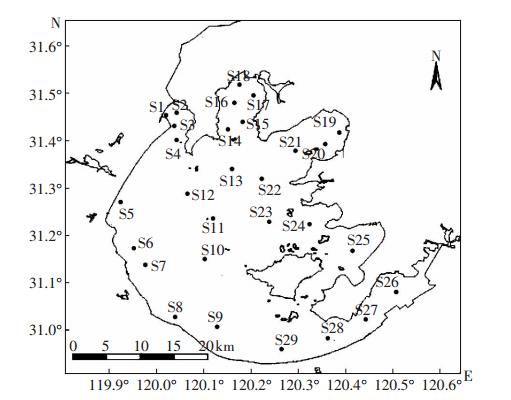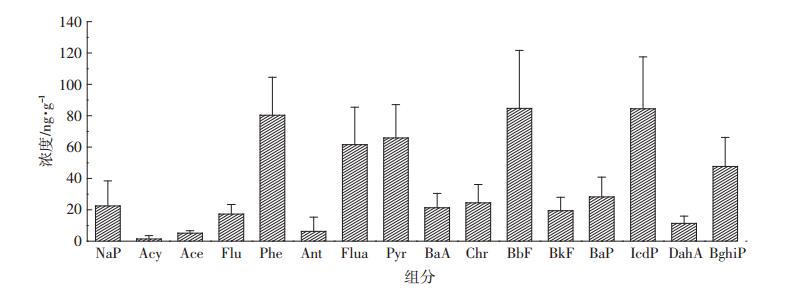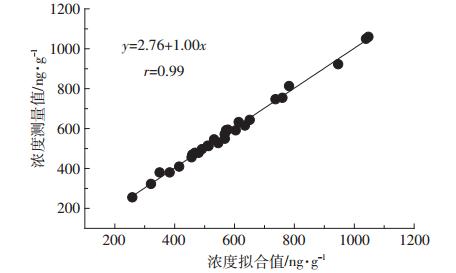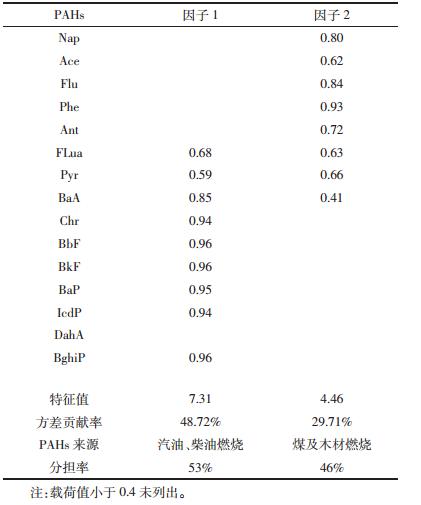文章信息
- 武婷, 刘贵荣, 田瑛泽, 杨勇, 贾晓波, 张远, 郭昌胜
- WU Ting, LIU Gui-rong, TIAN Ying-ze, Yang Yong, JIA Xiao-bo, ZHANG Yuan, GUO Chang-sheng
- 太湖底泥多环芳烃分布及来源解析
- Spatial Distribution and Source Apportionment of PAHs in Sediments from Taihu Lake
- 农业环境科学学报, 2015, 34(1): 124-129
- Journal of Agro-Environment Science, 2015, 34(1): 124-129
- http://dx.doi.org/10.11654/jaes.2015.01.018
-
文章历史
- 收稿日期:2014-07-30
2. 南开大学环境科学与工程学院, 天津 300071;
3. 中国环境监测总站, 北京 100012;
4. 中国环境科学研究院, 环境基准与风险评估国家重点实验室, 北京 100012
2. Department of Environment Science and Engineering, Nankai University, Tianjin 300071, China;
3. China National Environmental Monitoring Center, Beijing 100012, China;
4. State Key Laboratory of Environmental Criteria and Risk Assessment, Chinese Research Academy of Environmental Sciences, Beijing 100012, China
多环芳烃(PAHs)是一种重要的持久性和半挥发性有机污染物,受到了国内外的广泛关注[1, 2, 3, 4, 5]。研究表明,多环芳烃具有溶解度低、蒸汽压小及辛醇-水分配系数高的特点,因而易被沉积物吸附[6],在河流和湖泊底泥中含量较高[7, 8]。太湖地处长三角区域,由于湖泊周边人口密度大、工业发展迅速,大量工业企业的煤炭燃烧、机动车尾气等排放的多环芳烃对太湖底泥造成了危害和风险[9, 10, 11, 12, 13, 14]。近年来,太湖水体和底泥中多环芳烃的研究已逐步得到重视,如乔敏等[15]分析了太湖沉积物中PAHs的生态和健康风险,张路等[16]研究了太湖底泥和堆场底泥中PAHs的分布和潜在生态风险等。目前关于太湖的研究主要针对底泥中PAHs的分布和健康风险评估,对于PAHs污染源,尤其是定量的来源解析研究则相对较少;其他相关研究主要针对太湖某部分水域进行研究,关于整个太湖水域底泥中PAHs研究相对较少。本文在太湖选取了29个采样点,对太湖底泥中多环芳烃含量水平的空间分布和来源进行了分析,并对其潜在致癌风险进行了评估,旨在为太湖多环芳烃的污染防治和有效管理提供参考。 1 材料与方法 1.1 样品采集与处理
本研究于2010年9月进行沉积物样品的采集,采样期间,利用GPS确定采样点具体位置,29处采样点分布在太湖各个湖区(图 1)。S1位于太滆运河与漕桥河交汇处,S2位于竺山湾,S4位于梅梁湾,S26和S29位于东太湖,S27位于西南太湖,S31位于西太湖(靠近岸边),其他各点均匀设置在太湖湖心区域。使用不锈钢抓斗式采泥器采集湖底表层沉积物(0~10 cm)。沉积物样品在保温箱中运至实验室后冷冻干燥保存(-20 ℃),研磨过 60 目筛后备用。样品采用加速溶剂萃取方法(ASE)萃取(US EPA 3545):准确秤取5.00 g 样品,加入100 ng回收率指示物,并与5 g 铜粉、2 g硅藻土充分混匀放入萃取池,萃取液为二氯甲烷·正己烷(体积比1∶1)。样品经加速溶剂萃取、旋转蒸发浓缩后用固相萃取柱净化(US EPA 3620B),12 mL 2% 丙酮/正己烷淋洗,平行蒸发浓缩至1 mL。选择离子模式(SIM)进行GC-MS分析。

|
| 图 1 太湖水域中采样点分布 Figure 1 Locations of sampling sites in Taihu Lake |
本研究中测定的PAHs主要包括16种同类物质:萘(Nap)、苊烯(Acy)、苊(Ace)、芴(Flu)、菲(Phe)、蒽(Aat)、荧蒽(Flua)、芘(Pyr)、苯并(a)蒽(BaA)、屈(Chr)、苯并(b)荧蒽(BbF)、苯并(k)荧蒽(BkF)、苯并(a)芘(BaP)、茚苯(1,2,3-cd)芘(IcdP)、二苯并(a,n)蒽(DahA)、苯并(ghi)苝(二萘嵌苯)(BghiP)。PAHs的测定采用安捷伦HP6890气相色谱,HP5972MSD质谱检测联用(HP6890GC-HP5972MSD)。色谱柱为HP-5MS石英毛细管色谱柱(50 m×0.32 mm×0.17 μm);载气为氦气,流速2.0 mL·min-1;柱前压12.5 Pa;进样口及气质传输线温度 290 ℃;程序升温起始温度80 ℃,维持5 min,然后以3 ℃·min-1的速率升温至290 ℃,保留30 min。
1.3 统计分析
相关性分析、主成分分析、聚类分析、回归分析采用SPSS 17.0软件,空间分析采用Arcgis 9.0软件,绘图采用Origin 8.0软件。
2 结果与讨论
2.1 底泥中PAHs含量及空间分布
29个点位样品的16种PAHs总量介于255.1~1 059.4 ng·g-1之间,平均值为580.5 ng·g-1。由图 2可以看出,靠近湖泊边缘的点位PAHs浓度较高,尤其是西北部点位,浓度最高,越接近湖中心PAHs浓度越低。这可能是由于湖泊边缘受到周围工业排放和居民生活污染影响较大,而越靠近湖中心受外界影响越小。此外,太湖北岸的河口较多,导致北岸底泥中PAHs浓度高于南岸。相关研究调查了太湖枯水季底泥中PAHs浓度[14],本研究结果表明,丰水季底泥中PAHs浓度较枯水季高,系因不同季节PAHs污染源排放强度不同所致。
由表 1可以看出,与国内的其他流域相比,太湖的PAHs浓度低于黄河兰州段、巢湖和海河,但高于黄河河南段的PAHs水平;与国外的流域比较,其浓度低于美国的萨吉诺河和日本的Saginaw河,与韩国的马山湾PAHs水平大致相当。
通过对太湖底泥中PAHs各组分平均浓度进行比较(图 3)可知,太湖底泥的16种PAHs平均浓度介于5.1~84.7 ng·g-1之间,其中BbF浓度水平最高,Acy的浓度最低,BbF、IcdP、Phe的平均浓度均超过80 ng·g-1,是太湖底泥中含量较高的污染物。上述组分的浓度与百分含量跟国内外其他水域底泥相比均有不同,主要由于排放源的强度不同所致。
PAHs来源复杂,总的来说可分为2大类:高温燃烧和石油类污染。研究[1, 23, 24, 25]表明,PAHs环数的相对含量能够反映PAHs的来源类型,大多数研究中使用低环(2环和3环)与高环(4环及以上)的比值来作为PAHs来源的标识[3, 26]。这是由于:高环主要来源于高温热解燃烧,低环则主要来源于石油类污染。以往的研究表明,低环与高环之比低于1时,表明PAHs主要来源于高温燃烧;该比值高于1时,则主要来自石油类污染[2, 27, 28]。本研究中,29个采样点中PAHs的低环/高环比值范围在0.23~0.91之间,平均值为0.52,表明PAHs主要来自于高温燃烧源。
为进一步明确PAHs的污染源类型,使用等级聚类分析[3, 29, 30],对29个底泥样品中PAHs的主要组分进行聚类。通过对PAHs组分进行聚类,结合标识元素分析,可以定性分析PAHs的主要污染源类型。本研究中,由于Acy在大多数底泥中未检出,只将15种PAHs组分纳入SPSS 17.0软件中进行聚类分析,结果如图 4所示。15种PAHs组分聚为2大类:BghiP、BbF、BaP、IcdP、BkF、Chr等组分聚在一组,其中BghiP、BkF、IcdP是柴油燃烧的标识元素[31],BaP、BbF、BghiP等通常是汽油燃烧源排放的重要组分[31, 32],因此汽油、柴油燃烧排放源可能是太湖底泥中PAHs的重要来源;NaP、Ant、Ace、Flu、Phe、Flua、BaA、Pyr、DahA等组分聚为另一组,其中Flu、Phe、Ant、Pyr等组分通常是燃煤源的特征排放组分,同时Phe、Ant等物质也是木材燃烧的标识元素,因此煤、木材燃烧也可能是本研究中PAHs的另一种重要来源。
主成分分析-多元线性回归(PCA-MLR)模型是一种重要的受体模型,能够定性识别进而定量解析大气、土壤、底泥中污染物的来源,本研究利用该模型分析太湖底泥中PAHs主要污染源类型及分担率。
将15种PAHs组分(Acy未检出)纳入PCA模型,经过Varimax旋转,提取出2个特征值大于1的因子。表 2列出了各因子载荷值,因子1中,Chr、BbF、BkF、BaP、IcdP、BghiP等组分载荷值较高,这些组分是汽油、柴油燃烧的标识元素,因此因子1可以识别为汽油、柴油燃烧源。太湖附近公路上的机动车排放以及湖面上捕鱼船的燃油排放,可能是该因子的最主要来源。因子2中,NaP、Flu、Phe、Ant等组分具有较高的载荷值,与等级聚类讨论相似,该因子可能是煤、木材燃烧排放源。太湖周边的工业企业以及农业活动,可能是该因子的主要来源。PCA的解析结果与等级聚类结果吻合。
根据PCA结果,将计算得到的绝对主因子得分作为自变量,与各点位的PAHs总浓度进行回归分析,计算各因子的贡献值(ng·g-1)。各因子的分担率,由下式计算得到:
分担率i = 贡献值i /ΣPAHs ×100% 各因子的分担率计算结果如表 2所示。汽油柴油燃烧源贡献显著,约占总PAHs来源的53%,而煤、木材燃烧相对较低,约占46%,这2种污染源类总共占据了总PAHs来源的99%。与国内外其他研究相比,太湖底泥中PAHs汽油、柴油燃烧源的贡献略低于黄河兰州段底泥中该源类的贡献(61%)[4]以及汉密尔顿港底泥中该源类的贡献(61%)[31];而太湖底泥中PAHs煤及木材燃烧源的贡献则高于黄河兰州段底泥中该源类的贡献(38%)[4]以及汉密尔顿港底泥中该源类的贡献(26%)[31]。源解析结果的差异主要是由于不同水域周边的车船、工业燃煤污染源活动强度不同所致。根据源解析结果,建议对太湖水面上汽油、柴油船舶的活动进行管理和控制,对湖泊周边工业企业、农业活动的煤炭及木材燃烧进行科学管控。
为检验PCA-MLR模型解析结果的优劣,将各底泥中PAHs的拟合值与测量值回归,如图 5所示。回归方程表明,拟合得到的截距值为2.76,斜率为1.00,相关系数达到0.99,拟合结果理想。
PAHs毒性受到广泛关注。长期以来,研究者利用BaP来评估PAHs的癌症风险[33, 34]。16种优控PAHs中,除了BaP以外,BaA、BbF、BkF、DahAn、IcdP等组分均具有较强的致癌性[33]。因此,很多研究利用BaPE(BaP当量浓度)定量评估底泥中PAHs潜在毒性。BaPE计算公式如下[32]:
[BaPE]i =[BaA]i ×0.06+[BbF]i ×0.07+[BkF]i ×0.07+[BaP]i +[DahA]i ×0.60+[IcdP]i ×0.08 评估结果表明,太湖底泥中PAHs的BaPE为(50.37±19.70)ng·g-1,说明具有一定的潜在毒性。
3 结论
(1)太湖底泥中的16种美国环境保护署优先控制PAHs中15种被普遍检出(Acy在大部分底泥中未检出)。ΣPAHs浓度范围为255.1~1 059.4 ng·g-1,平均值为580.5 ng·g-1。空间分析表明,湖边采集的底泥中PAHs浓度较高,湖心底泥中PAHs浓度较低,这是由于受到周边的工业、农业、交通的影响。16种PAHs中,BbF含量最高,达到84.7 ng·g-1。
(2)太湖底泥中PHAs的主要来源是汽油、柴油燃烧源以及煤、木材燃烧源。汽油、柴油燃烧源的分担率为53%,煤、木材燃烧源的分担率为46%。
(3)太湖底泥中PAHs的BaP当量浓度为(50.37±19.70)ng·g-1,说明具有一定的潜在毒性。

图 2 太湖底泥中PAHs空间分布
Figure 2 Spatial distribution of PAHs in sediments in Taihu Lake

图 3 太湖底泥中PAHs各组分平均浓度
Figure 3 Average concentrations of individual PAH compound in sediments in Taihu Lake

图 4 PAH 各组分等级聚类图
Figure 4 Hierarchical clustering of individual PAH compound

图 5 PAHs浓度拟合值对测量值回归
Figure 5 Regression of modeled and measured ΣPAHs concentrations
| [1] | 陈华林, 陈英旭, 沈梦蔚. 西湖底泥对多环芳烃(菲)的吸附性能[J]. 农业环境科学学报, 2003, 22(5):585-589. CHEN Hua-Lin, CHEN Ying-Xu, SHEN Meng-wei. Sorption properties of PAH (phenanthrene) on sediment in West Lake[J]. Journal of Agro-Environment Science, 2003, 22 (5):585- 589. |
| [2] | 周玲莉, 薛南冬, 李发生, 等. 黄淮平原农田土壤中多环芳烃的分布、风险及来源[J]. 中国环境科学, 2012, 32(7):1250-1256. ZHOU Ling-li, XUE Nan-dong, LI Fa-sheng, et al. Distribution, source analysis and risk assessment of polycyclic aromatic hydrocarbons in farmland soils in Huanghuai Plain[J]. China Environmental Science, 2012, 32(7):1250-1256. |
| [3] | Li W H, Tian Y Z, Shi G L, et al. Concentrations and sources of PAHs in surface sediments of the Fenhe reservoir and watershed, China[J]. Ecotoxicology and Environmental Safety, 2012, 75(1):198-206. |
| [4] | Shi G L, Tian Y Z, Guo C S, et al. Sediment-pore water partition of PAH source contributions to the Yellow River using two receptor models[J]. Journal of Soils and Sediments, 2012, 12(7):1154-1163. |
| [5] | 冯焕银, 傅晓钦, 赵 倩, 等. 宁波土壤中多环芳烃的健康风险评价[J]. 农业环境科学学报, 2011, 30(10):1998-2004. FENG Huan-yin, FU Xiao-Qin, ZHAO Qian, et al. Health risk assessment of polycyclic aromatic hydrocarbons in soils of Ningbo area, China[J]. Journal of Agro-Environment Science, 2011, 30(10):1998-2004. |
| [6] | 许士奋, 蒋 新, 王连生, 等. 长江和辽河沉积物中的多环芳烃类污染物[J]. 中国环境科学, 2000, 20(2):128-131. XU Shi-fen, JIANG Xin, WANG Lian-sheng, et al. Polycyclic aromatic hyfrocarbons(PAHs) pollutants in sediments of the Yangtse River and the Liaohe River[J]. China Environmental Science, 2000, 20(2):128-131. |
| [7] | Manariotis I D, Karapanagioti H K, Chrysikopoulos C V. Degradation of PAHs by high frequency ultrasound[J]. Water Research, 2011, 45(8):2587-2594. |
| [8] | 罗固源, 朱 虹, 许晓毅, 等. 长江底泥对多环芳烃的吸附行为及荧光分析[J]. 环境科学与技术, 2010, 33(12):1-5. LUO Gu-yuan, ZHU Hong, XU Xiao-yi, et al. Sorption behaviors of polycyclic aromatic hydrocarbon on surface sediment in Chongqing section of the Yangtze River[J]. Environmental Science & Technology, 2010, 33 (12):1-5. |
| [9] | 李玉斌, 刘征涛, 冯 流, 等. 太湖部分沉积物中多环芳烃生态风险评估[J]. 环境化学, 2011, 30(10):1769-1774. LI Yu-bin, LIU Zheng-tao, FENG Liu, et al. Ecological risk assesment of PAHs in the sediments from Taihu Lake[J]. Environmental Chemistry, 2011, 30(10):1769-1774. |
| [10] | 郭广慧, 吴丰昌, 何宏平, 等. 基于不确定性分析的太湖水体多环芳烃的生态风险评价[J]. 环境科学, 2012, 33(4):1091-1097. GUO Guang-hui, WU Feng-chang, HE Hong-ping, et al. Uncertainty characterization approaches for ecological risk assessment of polycyclic aromatic hydrocarbon in Taihu Lake[J]. Environmental Science, 2012, 33(4): 1091-1097. |
| [11] | 余云龙, 李圆圆, 林 田, 等. 太湖表层沉积物中多环芳烃的污染现状及来源分析[J]. 环境化学, 2013, 32(12):2336-2341. YU Yun-long, LI Yuan-yuan, LIN Tian, et al. Distribution and sources of polycyclic aromatic hydrocarbons in surface sediments from Taihu Lake[J]. Environmental Chemistry, 2013, 32 (12):2336-2341. |
| [12] | 舒卫先, 李世杰. 太湖流域典型湖泊表层沉积物中多环芳烃污染特征[J]. 农业环境科学学报, 2008, 27(4):1409-1414. SHU Wei-xian, LI Shi-jie. Pollution characteristics of polycyclic aromatic hydrocarbons(PAHs) in the surface sediment from two typical lakes in the Taihu Basin[J]. Journal of Agro-Environment Science, 2008, 27(4):1409-1414. |
| [13] | 刘国卿, 张 干, 金章东, 等. 太湖多环芳烃的历史沉积记录[J]. 环境科学学报, 2006, 26(6):981-986. LIU Guo-qing, ZHANG Gan, JIN Zhang-dong, et al. Sedimentary record of polycyclic aromatic hydrocarbons in the Taihu Lake[J]. Acta Scientiae Circumstantiae, 2006, 26(6):981-986. |
| [14] | Zhang Y, Shi G L, Guo C S, et al. Seasonal variations of concentrations, profiles and possible sources of polycyclic aromatic hydrocarbons in sediments from Taihu Lake, China[J]. Journal of Soil Sediments, 2012, 12:933-941. |
| [15] | 乔 敏, 黄圣彪, 朱永官, 等. 太湖梅梁湾沉积物中多环芳烃的生态和健康风险[J]. 生态毒理学报, 2007, 2(4):456-463. QIAO Min, HUANG Sheng-biao, ZHU Yong-guan, et al. Ecological risk assessment of polycyclic aromatic hydrocarbons in sediments of Meiliang Bay, Taihu Lake[J]. Asian Journal of Ecotoxicology, 2007, 2 (4):456-463. |
| [16] | 张 路, 范成新, 鲜启鸣, 等. 太湖底泥和疏竣堆场中持久性有机污染物的分布及潜在生态风险[J]. 湖泊科学, 2007, 19(1):18-24. ZHANG Lu, FAN Cheng-Xin, XIAN Qi-ming, et al. Persistent organic pollutants(POPs) distribution and potential ecological risk on sediment in Lake Taihu and slurry stockyard[J]. Journal of Lake Sciences, 2007, 19 (1):18-24. |
| [17] | Xu J, Yu Y, Wang P, et al. Polycyclic aromatic hydrocarbons in the surface sediments from Yellow River, China[J]. Chemosphere, 2007, 67(7):1408-1414. |
| [18] | Jiang B, Zheng H L, Huang G Q, et al. Characterization and distribution of polycyclic aromatic hydrocarbon in sediments of Haihe River, Tianjin, China[J]. Journal of Environment Sciences, 2007, 19(3):306-311. |
| [19] | Sun J H, Wang G L, Chai Y, et al. Distribution of polycyclic aromatic hydrocarbons(PAHs) in Henan Reach of the Yellow River, Middle China[J]. Ecotoxicology and Environment Safety, 2009, 72(5):1614-1624. |
| [20] | Wang J Z, Zhang K, Liang B, et al. Occurrence, source apportionment and toxicity assessment of polycyclic aromatic hydrocarbons in surface sediments of Chaohu, one of the most polluted lakes in China[J]. Journal of Environmental Monitoring, 2011, 12:3336-3342. |
| [21] | Horii Y, Ohura T, Yamashita N, et al. Chlorinated polycyclic aromatic hydrocarbons in sediments from industrial areas in Japan and the United States[J]. Archives of Environment Contamination and Toxicology, 2009, 57(4):651-660. |
| [22] | Yim U H, Hong S H, Shim W J, et al. Spatio-temporal distribution and characteristics of PAHs in sediments from Masan Bay, Korea[J]. Marine Pollutution Bulletin, 2005, 50(3):319-326. |
| [23] | 段凤魁, 贺克斌, 马永亮. 北京PM2.5中多环芳烃的污染特征及来源研究[J]. 环境科学学报, 2009, 29(7):1363-1371. DUAN Feng-kui, HE Ke-bin, MA Yong-liang. Concentration and sources of atmospheric polycyclic aromatic hydrocarbons(PAHs) in PM2.5 in Beijing[J]. Acta Scientiae Circumstantiae, 2009, 29(7):1363-1371. |
| [24] | Yunker M B, Macdonald R W, Vingarzan R, et al. PAHs in the Fraser River basin:A critical appraisal of PAH ratios as indicators of PAH source and composition[J]. Organic Geochemistry, 2002, 33(4):489-515. |
| [25] | Wang H S, Cheng Z, Liang P, et al. Characterization of PAHs in surface sediments of aquaculture farms around the Pearl River Delta[J]. Ecotoxicology and Environment Safety, 2010, 73(5):900-906. |
| [26] | Feng C L, Xia X H, Shen Z Y, et al. Distribution and sources of polycyclic aromatic hydrocarbons in Wuhan section of the Yangtze River, China[J]. Environmental Monitoring and Assessment, 2007, 133(1):447-458. |
| [27] | Soclo H, Garrigues P, Ewald M. Origin of polycyclic aromatic hydrocarbons(PAHs) in coastal marine sediments:Case studies in Cotonou (Benin) and Aquitaine(France) areas[J]. Marine Pollution Bulletin, 2000, 40(5):387-396. |
| [28] | 焦文涛, 吕永龙, 王铁宇, 等. 化工区土壤中多环芳烃的污染特征及其来源分析[J]. 环境科学, 2009, 30(4):1166-1172. JIAO Wen-tao, Lü Yong-long, WANG Tie-yu, et al. Characteristics and sources of polycyclic aromatic hydrocarbons in surface soil from chemical industrial areas[J]. Environmental Science, 2009, 30(4):1166-1172. |
| [29] | Garcia J H, Li W W, Arimoto R, et al. Characterization and implication of potential fugitive dust sources in the Paso del Notre region[J]. Science of the Total Environment, 2004, 325(1-3):95-112. |
| [30] | Shi G L, Feng Y C, Wu J H, et al. Source identification of polycyclic aromatic hydrocarbons in urban particulate matter of Tangshan, China[J]. Aerosol and Air Quality Research, 2009, 9:309-315. |
| [31] | Sofowote U M, Mccarry B E, Marvin C H. Source apportionment of PAH in Hamilton Harbour suspended sediments:Comparison of two factor analysis methods[J]. Environmental Science & Technology, 2008, 42(16):6007-6014. |
| [32] | Harrison R M, Smith D J T, Luhana L. Source apportionment of atmospheric polycyclic aromatic hydrocarbons collected from an urban location in Birmingham, U K[J]. Environmental Science & Technology, 1996, 30(3):825-832. |
| [33] | Xu J, Guo J Y, Liu G R, et al. Historical trends of concentrations, source contributions and toxicities for PAHs in dated sediment cores from five lakes in western China[J]. Science of the Total Environment, 2014, 470-471:519-526. |
| [34] | Liu W X, Dou H, Wei Z C, et al. Emission characteristics of polycyclic aromatic hydrocarbons from combustion of different residential coals in North China[J]. Science of the Total Environment, 2009, 407(4):1436-1446. |
 2015, Vol. 34
2015, Vol. 34






